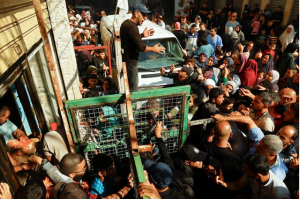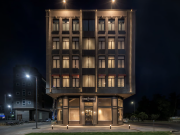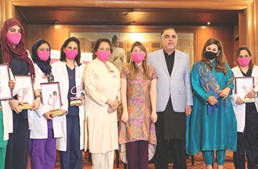GAZA: Israel warned Palestinians in the city of Khan Younis in the south again to move west, “out of the line of fire” and closer to aid. This is the latest sign that Israel plans to attack Hamas in south Gaza after controlling the north.

“People are being asked to move.” Israeli Prime Minister Benjamin Netanyahu’s spokesman, Mark Regev, told MSNBC on Friday, “We don’t want to see civilians caught in the crossfire. I know it’s not easy for many of them.”
This will force hundreds of thousands of Palestinians who fled south during Israel’s attack on Gaza City to move again, along with people who live in Khan Younis. This will make an already terrible humanitarian situation even worse.
More than 400,000 people live in Khan Younis.
After Hamas’s October 7 attack on Israel, in which 1,200 people were killed (new numbers from Israel) and 240 were taken hostage in the enclave, Israel vowed to wipe out the resistance group that rules the Gaza Strip.
Since then, Israel has bombed most of Gaza City, killing over 12,000 people, including 5,000 children. They have also directed the depopulation of the northern half of the enclave, which has left about two-thirds of the 2.3 million Palestinians who live in the strip without a home.
A lot of people who have fled are afraid that they might have to stay away for good.
The UN believes the numbers for the number of deaths in Gaza, but they are only updated every so often because it’s hard to get new information.
Israel put messages over the eastern parts of Khan Younis telling people to get to safety by dropping them from the sky. This makes it seem like military operations are about to start there.
To get rid of Hamas rebels hiding in underground tunnels and bunkers, Regev said that Israeli troops would have to move into the city. However, he said that there is no such “enormous infrastructure” in less populated areas to the west.
After that, he said, “I’m pretty sure that they won’t have to move again” if they move west. “We’re asking them to move to an area where hopefully there will be tents and a field hospital.”
He said that because the western areas are closer to the Rafah border crossing with Egypt, help could be sent there “as soon as possible.”
Deliveries of fuel
As the seventh week of the war began, there were no signs that it would end, even though people around the world were calling for a truce or at least a break for humanitarian reasons.
“We have readied ourselves for a long and steady defense from all sides.” “The occupation forces keep losing more and more people the longer they stay in Gaza,” Abu Ubaida, spokeswoman for Hamas’ armed wing, said in a video statement.
In the occupied West Bank, new fighting broke out. The Palestinian Red Crescent ambulance service said early Saturday that an Israeli attack on a house in the Balata refugee camp in the central city of Nablus killed at least five people and hurt two others.
The Israeli forces didn’t say anything right away.
Israel seemed to give in to international pressure on Friday, offering to let fuel trucks into Gaza and promising “no limitation” on aid asked for by the UN. This came after warnings that its siege would lead to disease and hunger.
At Washington’s request, Israel said it would let two truckloads of fuel a day through to help the UN meet its basic needs. It also talked about plans to give more aid in general.
“We will increase the capacity of the humanitarian convoys and trucks as long as there is a need,” Colonel Elad Goren from COGAT, the agency in the ministry of defense that handles administrative problems with the Palestinians, told reporters.
Israel has previously said it would let in help, but these comments seemed to show a change in tone after UN agencies said that humanitarian conditions in Gaza were quickly getting worse. For example, the World Food Program said there was a “immediate possibility of starvation.”
In a post on X, which used to be called Twitter, the White House said that it was “glad” that Israel agreed to the fuel deliveries and that they should “continue regularly and in larger amounts.”
Israel said that after searching Gaza’s main hospital, Al Shifa, for two days, its troops had found a vehicle with a lot of weapons in it and what it called a Hamas tunnel shaft.
However, there are a lot of doubts about the evidence that the Israeli military revealed.
The facility was one of the main targets of Israel’s ground attack, and the growing humanitarian situation has caused alarm around the world.
The army shared a video that it said showed the entrance to a tunnel in an outdoor area of the hospital. The area was full of sand, concrete and wood debris. It looked like the area had been dug up. In the distance, a bulldozer showed up.
Israel has long said that the hospital was built on top of a huge underground bunker that was home to Hamas’s command center. The people who work at the hospital say this is not true and that Israel’s results there have not yet proven this.
Hamas says they are not using hospitals for military reasons. It says that some hostages have been treated at medical centers, but they have not been kept there.
Child, hostage, die
A baby born before it was due died at the Al Shifa hospital on Friday. It was the fourth baby to die there in the days since Israeli forces attacked it in a very public way.
He was 85 years old and was held captive by Israel. Hamas said he died of a panic attack during an air strike.
In Modiin, Israel, a funeral was held for 19-year-old Israeli army recruit Noa Marciano. The Israeli military says they found her body in Gaza City near Shifa hospital on Thursday. During the October 7 Hamas attack, she was taken from a military camp.
The army also said it had found the body of Yehudit Weiss, a 65-year-old mother of five who was taken from Kibbutz Be’eri.
According to Russian news outlets, the Emergencies Ministry said that on Friday, 170 Russian citizens crossed from Gaza into Egypt. They were part of a group of about 200 people who managed to get out.










































